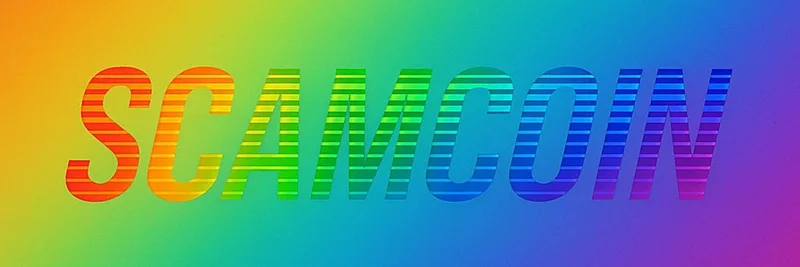If you’ve spent any time in the Solana meme coin scene, chances are you’ve seen the token SCAMCOIN—and yes, that’s really its name. Here’s what you need to know about this token, including why it’s become a lightning rod for attention, controversy, and caution in the crypto community.
What Is SCAMCOIN?
SCAMCOIN is an SPL token on the Solana blockchain, operating under the symbol SCAMCOIN and contract address 6gd5ubix2Ubzeup2ycUxSgWVKFTrSugLXFsqhBQRpump. Launched around July 9th-10th, 2025, it immediately raised eyebrows due to its self-aware name and has been labeled as unverified on platforms like Phantom Wallet and Solflare.
Market Data at a Glance
- Market Capitalization: Reports range from around $39K up to $1.2M, reflecting massive volatility. A mid-July estimate hovered near $312.9K.
- Circulating Supply: ~997–999 million SCAMCOIN.
- Liquidity: Liquidity pools across DEXes hover between $28K and $80K, which is relatively low compared to its trading volume.
- Trading Volume: Swings between a few thousand to several million dollars in 24 hours.
- Holders: Ranges from 150 to nearly 900 wallets, suggesting a small but active community.
How to Buy and Store SCAMCOIN
SCAMCOIN isn’t listed on big centralized exchanges; instead, it’s traded on Solana DEXes and managed with Solana-compatible wallets. The typical buying flow is:
- Download Phantom or Solflare.
- Fund your wallet with SOL.
- Use a DEX aggregator like Jupiter to swap SOL for SCAMCOIN (using the contract address for manual import).
- Always verify the contract address—copy it from a trusted source like Solscan.
For storage, both Phantom and Solflare are viable non-custodial options. For added protection, consider combining your software wallet with a hardware wallet like Ledger.
Risks, Red Flags, and Security Insights
SCAMCOIN’s name isn’t just a meme—it’s a warning. Here’s why you should exercise extreme caution:
- Unverified Status: Both Phantom and Solflare explicitly warn that SCAMCOIN is an unverified token. Unverified tokens haven’t passed official registry checks and are susceptible to scams or malicious code.
- Centralization Risk: AI-based audits flagged high centralization of token supply, meaning a small group could control the market. This setup is fertile ground for market manipulation or “rug pulls.”
- Developer Behavior: Some platforms have flagged SCAMCOIN with a "Dev sell all" alert, indicating that developers may have dumped their tokens—classic rug pull behavior.
- No Clear Utility: The token’s official story is “no roadmap, no VC, no promises—just memes.” In other words, it’s pure speculation, satirizing the prevalence of scams in crypto.
- Liquidity Concerns: Low liquidity combined with high trading volume means your ability to enter or exit positions without major slippage is limited.
- Volatility and Hype: Price swings of several hundred percent in a day are routine, often driven by viral posts on X (formerly Twitter) and Telegram.
For more on protecting yourself, use tools like RugCheck, Solscan, and Solsniffer to assess token risks, check liquidity locks, and verify mint authority.
Community Sentiment: Ironic, Divided, and Speculative
SCAMCOIN’s main appeal is its tongue-in-cheek branding. Some traders joke that it’s “the most honest token on Solana” because, at least, it doesn’t pretend to be more than a meme. Others are outright skeptical, warning of impending rug pulls and pointing out the tokenomics as intentionally unsustainable.
Posts on X highlight everything from so-called “whale activity” to last-minute buy signals, but the prevailing tone is one of buyer beware. As with most meme coins, the success (or failure) of SCAMCOIN is a function of hype, irony, and community FOMO.
How SCAMCOIN Compares to Other Solana Meme Coins
Solana’s meme coin ecosystem is notorious for its fast-moving, high-risk environment. Projects like BONK, WIF, and POPCAT at least try to build a narrative or use case. SCAMCOIN, on the other hand, takes the opposite approach—its lack of a roadmap is part of its “charm,” but also its biggest warning flag.
Pro Tips for Staying Safe
- Verify Before You Buy: Double-check the token address (here’s SCAMCOIN’s on Solscan).
- Use Small Amounts: Slippage can be intense, and you don’t want to be left holding worthless tokens.
- Monitor Social Channels: X and Reddit can offer early warnings of bad behavior—but beware of manufactured hype.
- Prioritize Security: Never share your seed phrase, avoid approving unknown transactions, and consider hardware wallets for larger holdings.
Final Thoughts
SCAMCOIN is a pure product of Solana’s meme coin era: fast, volatile, community-driven, and packed with both irony and risk. While its tongue-in-cheek marketing might be entertaining, the underlying risk profile—unverified status, liquidity issues, centralization, and developer sell flags—means it’s best treated as a speculative play for meme-savvy traders.
TL;DR: Only interact with SCAMCOIN if you’re fully aware of the risks and can afford to lose your investment. For newcomers, seasoned crypto veterans’ advice rings true: “DYOR” (Do Your Own Research) and never invest more than you can afford to lose.
Disclaimer: This article is for informational purposes only and does not constitute financial advice. Always conduct your own research before trading or investing in cryptocurrency assets.



